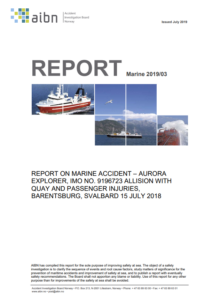Norway’s Accident Investigation Board has released its report on the 2018 Aurora Explorer allision, implicating the use of back-up mode operation in the incident. On July 15 2018, the Aurora Explorer vessel collided with a quay while docking at Barentsburg. During the arrival, the 125 French-passengers were standing on the open deck, resulting to many falling when the collision occurred. According to the report, one third of the passengers and one crew member suffered varying degrees of injury.
Of the total 125 persons on board, 37 persons, including a crew member, needed medical attention. A total of 19 persons were transferred by helicopter to Longyearbyen for further treatment. There were no life-threatening injuries, but nine passengers and one crew member were sent on to Tromsø University Hospital by air ambulance for further treatment.
The investigation that followed revealed the vessel was operated in back-up mode in order to achieve cruising speed under way. This allowed the possibility of operational error/oversight to arise, whereby a master could forget to re-set the system to combinator mode before docking.
[smlsubform prepend=”GET THE SAFETY4SEA IN YOUR INBOX!” showname=false emailtxt=”” emailholder=”Enter your email address” showsubmit=true submittxt=”Submit” jsthanks=false thankyou=”Thank you for subscribing to our mailing list”]
Yet, the company, aware of the possible dangers, did not document the potential risks to passengers and crew from the change in operational mode.
The vessel, after the collision suffered minor damage above the waterline, with no water ingress. In the meantime, no emissions or pollution of the sea were recorded.
In light of the incident and to ensure the safety of passengers and crew onboard, the Norwegian Authority issued a safety recommendation to Arctic explorer AS.
AIBN recommends Arctic Explorer AS to carry out and document risk assessments for all operational changes in order to ensure the safety of its passengers and crew.
Following the investigation and the safety recommendation, the company implemented the measures below:
- All passengers will be in their seats before and during docking;
- Signs have been installed onboard.
In addition, the Norwegian Maritime Authority introduced an immediate precaution, where the buttons for constant rpm on the manoeuvre console are protected by an extra cover to exclude the possibility of error.
The investigation also addressed the causes that resulted to the accident:
- The port pitch was set too high after the previous gearbox overhaul. This led to overload at certain rpm settings, which caused vibrations in the vessel.
- During the gearbox overhaul early in 2018, the supplier of the manoeuvring system was not contacted, in order to guarantee that the pitch and load were optimally adjusted.
- The service of the manoeuvring system carried out after the accident showed the necessity of using specialised technicians to guarantee optimal adjustment of pitch and throttle.
- A prompt and professional correction of the manoeuvring system, once detected that they had a problem, would probably have prevented the accident..
- The SMC Safety Officer/DOC holder in Denmark were not aware of the technical problems in the form of vibrations, or that the vessel periodically was operated in back-up mode underway..
- The shipping company had assessed neither the risk of nonconformity nor the risk that changes in the operational mode might involve for passenger safety.
- The shipping company’s requirements about how the vessel was to be operated in back-up mode were not documented.
- There was no written handover report between the masters.
For more information, click on the PDF herebelow
































































